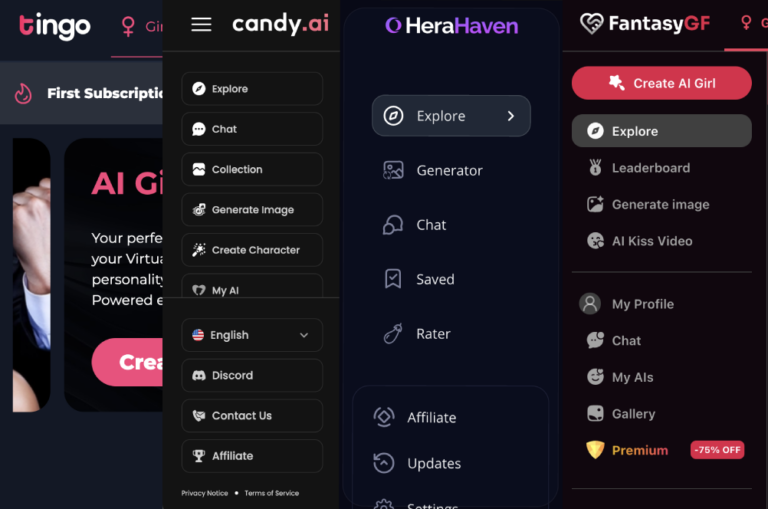The evolution of realistic AI chatbots marks a significant leap in the relationship between technology and human emotion. These AI systems are no longer limited to mechanical responses; they can understand, adapt to, and simulate human emotions, making interactions feel more personal and engaging. Whether used in customer service, virtual companionship, or creative storytelling, realistic AI chatbots are revolutionizing how we communicate and connect in the digital age.
In this article, we’ll explore how realistic AI chatbots are bridging the gap between technology and emotion, their key features, and the profound impact they are having on various industries and personal interactions.
1. What Makes an AI Chatbot Realistic?
A realistic AI chatbot combines advanced technologies like Natural Language Processing (NLP), Machine Learning (ML), and emotional intelligence to deliver human-like conversations. These chatbots go beyond surface-level responses, engaging users in dynamic and empathetic interactions.
Key Characteristics of Realistic AI Chatbots:
- Context Awareness: Understands the context of a conversation and responds accordingly.
- Emotional Intelligence: Detects user emotions and adjusts tone and behavior to match.
- Adaptability: Learns from interactions to improve future conversations.
- Customization: Allows users to tailor chatbot personalities and conversational styles.
Example: Platforms like Nemora.ai excel in creating realistic AI chatbots that provide emotionally engaging and customizable interactions.
2. How Realistic AI Chatbots Work
Realistic AI chatbots rely on a blend of cutting-edge technologies to achieve lifelike interactions. Here’s how they work:
2.1 Natural Language Processing (NLP)
NLP enables chatbots to:
- Understand complex user inputs, including slang and nuanced language.
- Generate contextually appropriate and coherent responses.
2.2 Emotional Intelligence
Using sentiment analysis, these chatbots:
- Detect emotional cues in user text (e.g., happiness, frustration, sadness).
- Respond empathetically, creating meaningful and supportive interactions.
2.3 Machine Learning (ML)
Machine learning allows chatbots to:
- Improve over time by analyzing user interactions.
- Personalize responses based on past conversations.
2.4 Customization Engines
Advanced platforms like Nemora.ai provide tools to:
- Design AI companions with unique appearances and personalities.
- Tailor interaction styles to suit personal or professional needs.
3. Applications of Realistic AI Chatbots
The versatility of realistic AI chatbots makes them invaluable across various sectors, enhancing both personal and professional interactions.
3.1 Virtual Companionship
Platforms like Nemora.ai offer customizable AI companions for emotional support, roleplay, and storytelling.
Features:
- Custom Personalities: Design companions with traits like empathy, humor, or intelligence.
- Roleplay Scenarios: Engage in creative and immersive narratives.
- NSFW Options: Explore unfiltered and mature content in a private setting.
Impact:
Virtual companions provide consistent emotional support, foster creativity, and offer judgment-free spaces for exploration.
3.2 Customer Support
Realistic AI chatbots streamline customer service, providing quick and efficient solutions.
Features:
- Automated Responses: Handle FAQs and common issues instantly.
- Escalation to Human Agents: Pass complex queries to humans when needed.
- 24/7 Availability: Ensure customer satisfaction round the clock.
Impact:
Improves response times, reduces operational costs, and enhances user satisfaction.
3.3 Education and Training
AI chatbots serve as virtual tutors, offering personalized learning experiences.
Features:
- Interactive Lessons: Simulate one-on-one tutoring sessions.
- Language Practice: Engage in real-time conversations for language learners.
- Progress Tracking: Monitor and adapt to a learner’s performance.
Impact:
Makes education more accessible, flexible, and tailored to individual needs.
3.4 Healthcare and Mental Health
In healthcare, realistic AI chatbots assist in providing support, information, and engagement.
Features:
- Symptom Checkers: Guide patients in understanding potential health concerns.
- Therapeutic Conversations: Offer mental health support and self-help resources.
- Appointment Management: Automate scheduling and reminders.
Impact:
Enhances patient engagement and provides immediate access to support.
4. Bridging the Gap Between Technology and Emotion
Realistic AI chatbots are transforming online interactions by humanizing technology. Here’s how they bridge the gap:
4.1 Simulating Emotional Depth
- Chatbots with emotional intelligence recognize and adapt to user feelings, creating authentic connections.
- Example: A chatbot offering words of encouragement during a stressful conversation.
4.2 Personalization at Scale
- By customizing chatbots to individual preferences, users feel more understood and valued.
- Example: A personalized virtual companion that remembers your favorite topics.
4.3 Enhancing Trust
- Realistic AI chatbots provide consistent and empathetic interactions, fostering trust in users.
- Example: A healthcare chatbot reassuring patients with accurate and supportive information.
5. Ethical Considerations
As AI chatbots become more realistic, ethical challenges arise. Developers and users must navigate these responsibly:
5.1 Privacy and Data Security
- Ensure user data is encrypted and not stored without consent.
- Platforms like Nemora.ai implement robust privacy measures.
5.2 Transparency
- Clearly communicate chatbot capabilities and limitations to users.
5.3 Avoiding Over-Reliance
- Balance AI interactions with human connections to avoid emotional detachment.
6. The Future of Realistic AI Chatbots
Advancements in AI technology will continue to enhance the realism and capabilities of chatbots. Here’s what the future may hold:
6.1 Virtual Reality Integration
- Combine chatbots with VR to create fully immersive experiences.
6.2 Deeper Emotional Understanding
- AI capable of detecting subtle emotional changes through text and voice.
6.3 Enhanced Creativity
- Chatbots that co-create content like stories, music, or art with users.
7. Why Nemora.ai Leads in Realistic AI Chatbots
Among the many platforms available, Nemora.ai stands out for its focus on personalization, emotional intelligence, and ethical design.
Key Features of Nemora.ai:
- Complete Customization: Design chatbots that match your unique needs and preferences.
- Dynamic Roleplay Tools: Create and explore immersive storytelling scenarios.
- Privacy-Centered Design: Enjoy secure, encrypted conversations.
- Emotional Engagement: Interact with chatbots that adapt to your mood and tone.
8. Conclusion
Realistic AI chatbots are transforming the digital landscape by bridging the gap between technology and human emotion. From personal companions to professional assistants, these AI systems deliver meaningful and engaging experiences that redefine how we connect online.
Ready to experience the future of realistic AI chatbots? Visit Nemora.ai today and explore how technology and emotion come together to create something extraordinary.


